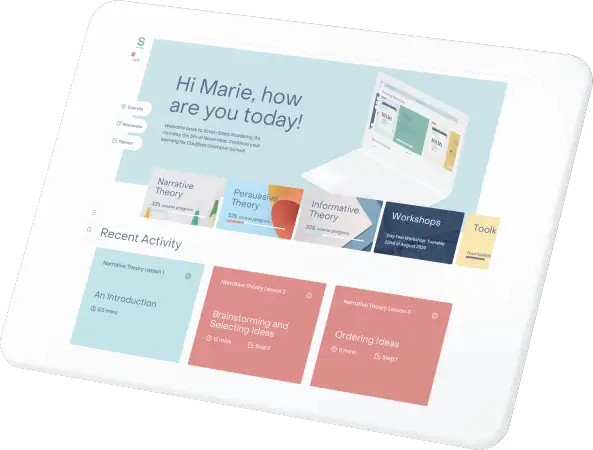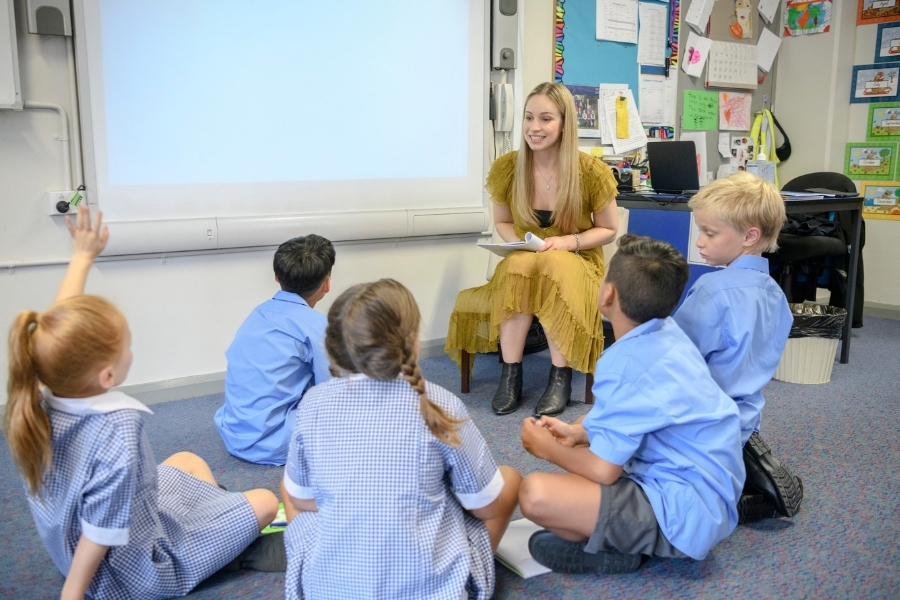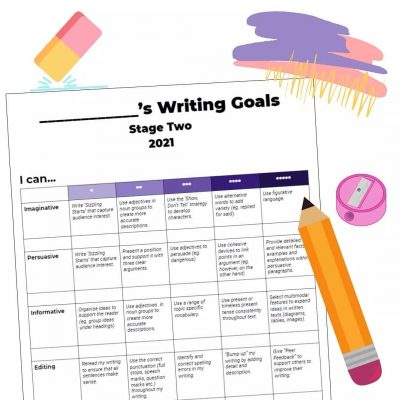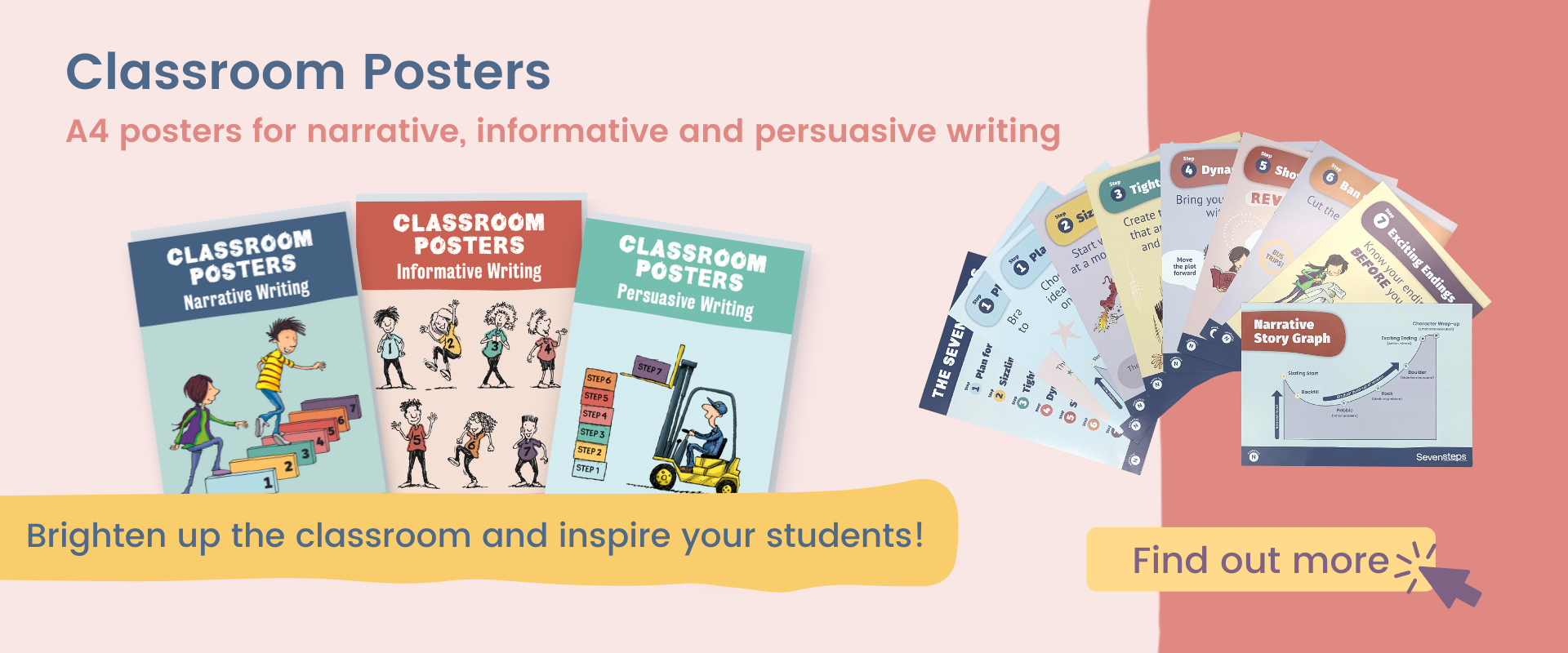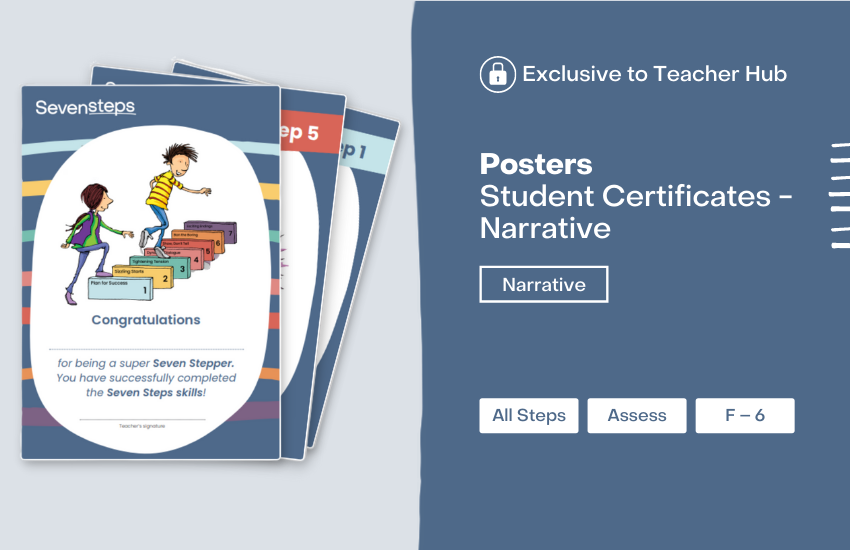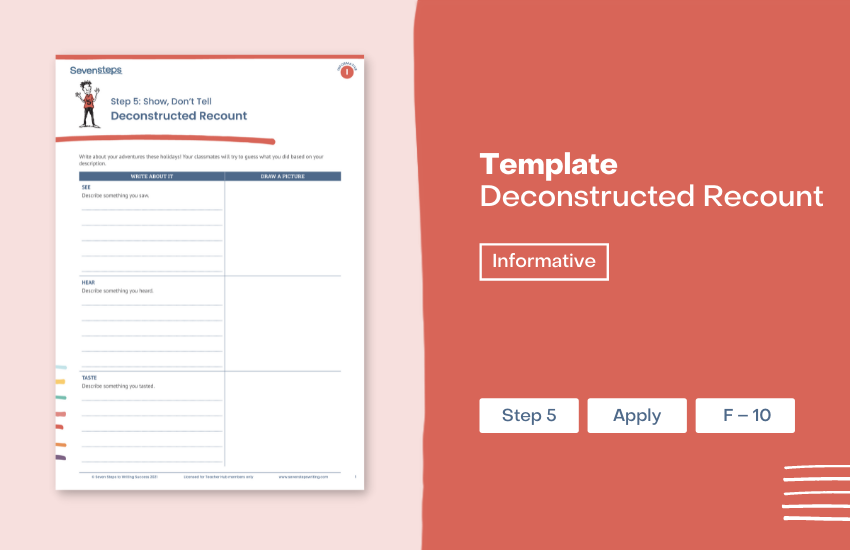With so many things to organise and skills to teach, it’s important to also create space for creativity and enjoyment in the writing classroom. Let’s bring the fun back into writing this term!
Here are some simple, practical and fun back-to-school tips to implement in the classroom. This is in no way an exhaustive list or a ‘must-do’ checklist. It’s a set of ideas that have been proven to improve students’ writing ability and to help students enjoy writing and develop strong foundational skills.
Back-to-school tips for your writing classroom
- Help students create their own writing goals
- Celebrate every success
- Bring excitement to holiday recounts
- Get verbal with lower-primary students
- Assess and create a game plan
- Focus on building ideas
- Model great writing
- Start an argument (seriously!)
- Guide students towards independence
- Top tech tools for teachers
1. Help students create their own writing goals
Goal-setting increases motivation and provides a path to success by creating a clear focus and purpose. As a teacher, you have goals for your writing classroom based on the curriculum and your own expectations – but do your students have a goal?
Students do better when they feel in control of their learning. When they take ownership of their learning, it sparks an internal drive to achieve their goals and gives them a greater sense of joy when they succeed.
4 steps to setting writing goals:
- Create short-term goals (4–6 weeks) with daily or weekly check-ins.
- Plan together. Review past writing with your students, create guidelines for setting goals and teach them how to make a plan.
- Make it visual with colourful charts and tables. Seeing their own progress is powerful for students.
- Celebrate their wins! Create a Wow Wall, or give out certificates, prizes and extra perks (see our next tip).
We asked Karrine Beasley (@sheteachesprimary), a Stage 2 teacher from NSW, about her approach to writing goals with her students:
‘One of the issues students face when setting writing goals is that they aren’t quite sure what their next step should be.
Students would come up with things like “My goal is to write more”, “My goal is to write better” or “My goal is to write 10 stories”. I realised I needed to align student goal-setting with our success criteria, and make these connections visible to students.
For teachers wanting to work with students to set purposeful goals, I would encourage you to make your expectations of quality writing super clear.
Before setting goals, share examples of quality texts and work with students to annotate the strengths and areas for improvement in a range of examples. You could display these on a class ‘Bump It Up’ wall, or work with students to develop rubrics defining the characteristics of quality texts.
Once students can clearly see and articulate what they are aiming for, they will be better equipped to start selecting the goals that will move them towards improving their writing.’
For a copy of Karrine’s student writing goals checklist (pictured below), contact her on Instagram.
2. Celebrate every success
Make an impact on your students by using positive reinforcement and words of encouragement every day. As we head into a new term, try to incorporate the following tips around celebrating each success to your students.
- Create the ultimate inspirational space! The classroom is every teacher’s learning lab, the place where you capture your students’ attention and inspire greatness. A great way to celebrate writing is to create a ‘theme wall’: a wall in your classroom dedicated to visualising the Seven Steps (e.g. with a set of classroom posters) and writing in general. When students see these colourful, inspirational displays – or, even better, when their own work is displayed – it provides the best encouragement and reinforcement that they’re doing a great job!
- Another wonderful way to celebrate a student’s success is to write them a note of encouragement. This may be a small gesture, but it shows the student that you’ve gone out of your way to write them a positive message. You could even make a short, fun appreciation video!
Knowing that you acknowledge their uniqueness and recognise their efforts can increase the student’s confidence, boosting them to keep that positive momentum going.
Completed teaching a Step?
Reward and motivate your students with a certificate.
Download from Teacher Hub a certificate for students who successfully incorporate a Step in their writing, as well as a certificate for students who have completed all Seven Steps.
3. Bring excitement to holiday recounts
A fly buzzes drearily against the window. Your eyes drift closed. Fourteen identical student holiday recounts done; only another 12 to go.
It doesn’t have to be like this! Start the new term with a gift to yourself by teaching your class how to write a truly captivating holiday recount. Show students how to Ban the Boring in recount writing with a fun, fast lesson in brainstorming and selecting ideas.
Use our deconstructed recount activity to show students that ‘Think First, Write Second’ really makes a difference, and help them to practise generating lots of ideas before choosing the best one. Read the Year 6 student writing example below to see just how captivating a recount can be!
‘My stomach felt like it had been flipped. Mr. Wilson, our school principal, reported in the morning the lake was calm. He was wrong!
Waves tumbled and smashed, Sabienne and I struggled to turn the kayak. The Bok-choy Fighters were screaming, chanting and singing. We turned the kayak around to Adam, so close now! The other team was only just getting in the water. I’m excited. I start to paddle with all my might.’
– Jessi, Year 6 student
[Related blog]: 4 recounts every teacher wants to read
STEP Step 5: Show, Don’t Tell
PURPOSE Apply
RESOURCE TYPE Template
YEAR F–10
- Take recounts to the next level with this simple template that promotes descriptive writing.
- Students write and draw in the template to describe their holidays using the Five + 1 Senses.
4. Get verbal with lower-primary students
The very first steps in becoming a great writer don’t actually require students to write.
Beginner writers can develop authorial skills well before they can write full sentences. How? Through oral language activities and brainstorming practice.
By starting the term with fun, short sessions that include plenty of repetition, lower-primary teachers can train students to create imaginative ideas, select the best ideas, and sequence them to follow a narrative structure. This lets the students lay the foundations for future writing, for the rest of the school year and beyond.
In our blog post for lower primary teachers, we take you through five fabulous ideas for oral language activities that will help beginners emerge into writing.
- Play guessing games that require deduction.
- Change it up.
- Sound out starts.
- Round-robin stories.
- Focus on body language.
Teach students to think like writers, and the craft of writing will come more naturally to them.
Need practical guidance for your beginner writers? Book your spot at our engaging and practical online session and learn how to apply the Seven Steps with your beginner writers. Sessions running every term.
5. Assess and create a game plan
It’s crucial to gauge your students’ writing ability at the start of each term, so what’s the best way to get a benchmark of your students’ writing?
NAPLAN’s writing task is a great model to follow.
- Give your students a topic.
- Set a timer for 15 minutes to allow them to plan.
- Unleash your writers – give them 40 minutes to write on the topic.
Students will be a little rusty, but that’s okay. You’re just trying to identify areas of weakness so that you can focus your writing lessons.
Use the Seven Steps to address the specific needs of your students:
- Are too many stories finishing with ‘And then they woke up’? Focus on Step 7: Exciting Endings.
- Are their persuasive texts repetitive and boring? Step 5: Show, Don’t Tell will give life to their writing.
- Is there an overall lack of structure and originality in their writing? Step 1: Plan for Success will be key!
Teacher Hub
- Track Your Success – a simple tool to help you test your students and analyse their results – Narrative, Persuasive and Informative
- Feedback Rubrics – Narrative, Persuasive and Informative
- Seven Steps Marking Guides – Narrative, Persuasive and Informative
Download our ‘Making Real Change in Schools’ report.
See how 69% of students improved by more than one entire NAPLAN band within an average of just 10 weeks!
6. Focus on building ideas
Writer’s block: it’s not a myth!
If we can experience it as adults, imagine how challenging it must be for children! Students often face obstacles when they need to come up with ideas – they may have limited life experience to draw from, or lack the skills to find inspiration.
This is why teachers often hear, ‘I don’t know what to write!’
Stick around … we can help you turn those blank pages into an abundance of creative ideas. Banish writer’s block and watch the ideas roll in!

Sticky Situations Activity
- On a Post-it note, have students draw or write about something that didn’t go to plan at an event. It could be Christmas lunch, a sports game or a sleepover.
- As a class, rank these Sticky Situations from most to least easy to overcome.
- Students can select three of their favourite situations to create a whole storyline!
This is a great activity to help your class understand the concept of pebble, rock, boulder, or to write a piece for each stage.
More activities to help inspire ideas:
- Two activities and a secret tip to help your students hunt for ideas.
- Simple tips and activities to help students write unique stories
7. Model great writing
One of the best ways to learn is to see examples. Immersing students in great writing is the best way to model the techniques that you expect from them.
Use a range of exemplars
The great news is that because Seven Steps focuses on authorial skills used by professional writers, there are exemplars everywhere! Books, movies, articles, speeches, documentaries and even cat videos are great for showing these techniques in action when students are learning the concepts and starting to think like writers.
View our collection of texts that demonstrate the Seven Steps and share with your students:
Narrative Texts Demonstrating the Seven Steps
STEP All Steps
PURPOSE Teach
RESOURCE TYPE List
YEAR F–10
- Show students examples of the Seven Steps techniques in published texts.
- This handy list is sorted by Step and annotated with notes about how each text demonstrates a particular Seven Steps technique.
- Selection includes picture books and chapter books, from classics to more recent titles.
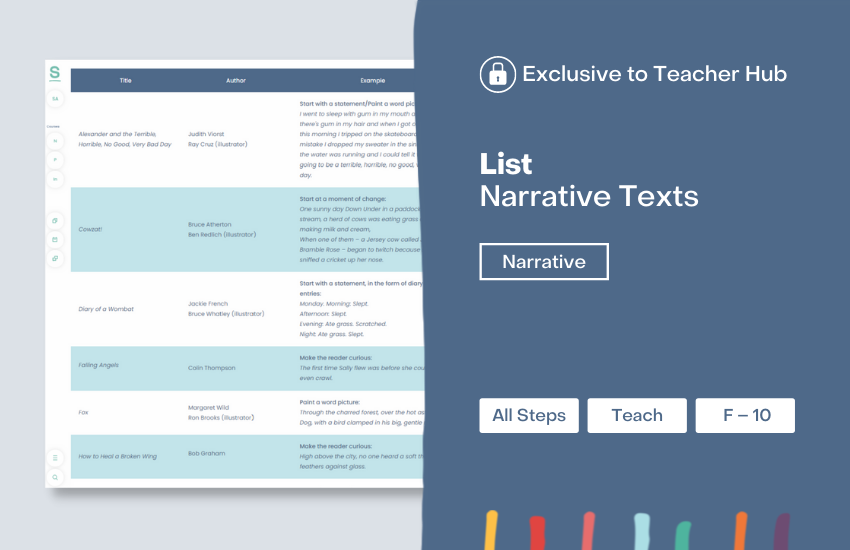
Persuasive Texts Demonstrating the Seven Steps
STEP All Steps
PURPOSE Teach
RESOURCE TYPE List
YEAR F–10
- Show students examples of the Seven Steps techniques in published texts.
- This handy list is sorted by Step and annotated with notes about how each text demonstrates a particular Seven Steps technique.
- Selection includes picture books, advertisements and speech transcripts.
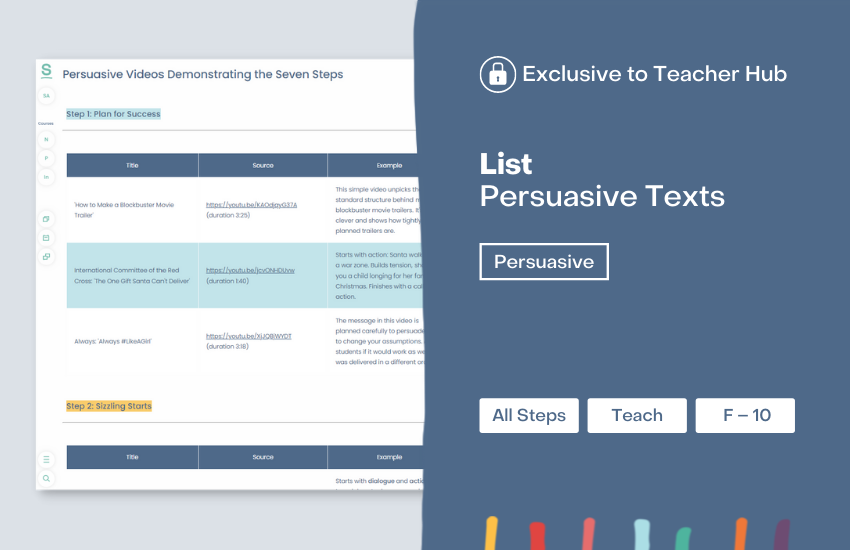
Informative Texts Demonstrating the Seven Steps
STEP All Steps
PURPOSE Teach
RESOURCE TYPE List
YEAR F–10
- Show students examples of the Seven Steps techniques in published texts.
- This handy list is sorted by Step and annotated with notes about how each text demonstrates a particular Seven Steps technique.
- Selection includes picture books, news articles and science comics.
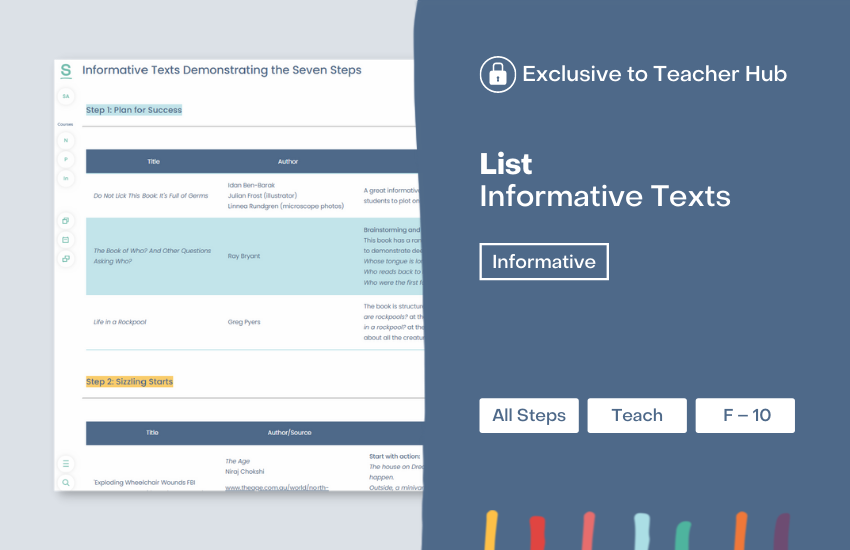
Use student exemplars
It’s also important for students to see examples of great writing from other students. This helps to model what you expect from students at a similar year level. Take a look at the winning entries from our Narrative Writing Competition and Persuasive Writing Competition. You can download an array of annotated writing samples in Teacher Hub’s Resource Library.
Encourage students to share their writing
Your students are modelling great writing every day in the classroom. Make time for students to share their work with fellow students. This does four things:
- Celebrates success – reading aloud is a form of publication.
- Enables feedback – feedback from their peers may be verbal or they might respond with laughter engagement, or a few polite nods.
- Models other students’ work – they can see what techniques are working well and get inspiration from each other.
- Allows students to compare and contrast their work – this is a great starting point for self-assessment.
8. Start an argument (seriously)
If you’ve ever heard a three-year-old negotiating for one more story before bed, you’ll realise that children have an innate ability to put forward an argument. However, the art of persuasion is something that needs to be modelled and developed over time.
Show students what great persuasive writing looks like.
Not just the traditional persuasive essays, but all types of persuasive writing from advertisements to debates and even political cartoons.
Use the winning student entries from our Persuasive Writing Competition (categories included speeches, op-eds and book reviews).
You can access a range of writing samples and exemplars on Teacher Hub including Persuasive Texts Demonstrating the Seven Steps.
Once students know what it looks like, then they can talk about it!
Have students express their opinions verbally in discussions, debates, speeches and presentations. This is the starting point for great writing and will expose students to different perspectives. It also makes persuasive writing a lot more accessible for all ability levels, and a lot more fun!
Now that the ideas are flowing, it’s time to start writing them down.
Use the following resources to put these tips into practice:
- Group activity for persuasive writing: Create a set of lessons around a persuasive speech, an op-ed or a book review.
- There are Seven Steps Persuasive Lesson Plans, Action Activities, Challenge Cards, Writing Prompts and Game Cards all in Teacher Hub’s Resource Library.
- The new activities in the Persuasive Writing Manual (Second Edition) are highly engaging using current topics and multi-modal literacy, which are easily adaptable to a range of age groups.
9. Guide students towards independence
The Seven Steps are the building blocks to great writing, but how do you progress students from mastering the individual Steps to writing a full text?
This is a challenge, but an important one, as it’s the next step to developing great writers!
- Collaborative writing is a wonderful way to support your students’ learning – it ‘chunks’ the task of writing, which is a key focus of the Seven Steps. Students begin by writing a text in groups, then we gradually reduce the scaffolds until they can write independently. The beauty of this approach is that students can learn from each other along the way and feel supported. Follow this simple three-step process!
- Deb Larmer, one of our expert Seven Steps presenters and an experienced teacher, shares another technique – visualisation:
‘I ask my Year 6 class to visualise what the finished story will look like. Verbalise your goal to a friend or teacher (even another teacher). This helps to internalise it.Once you see it and BELIEVE in it you are more likely to achieve it. Do this at the start of the year as a class then get students to do it on their own. It will start moving them towards independent learning and writing.’
10. Top tech tools for teachers
Many of you have likely become very adept at incorporating technology into your teaching! As you know, these skills aren’t just for the remote teaching world – they’re fantastic to use in the classroom too.
Here are two great resources to help you use the magic of technology to teach the Seven Steps.
Apps and software
Using different apps and software can be a great way to incorporate digital technology into the classroom.
We’ve suggested one for each Step, along with fun and engaging activity ideas.
Multimedia texts
Who says writing has to involve pens and paper? You can also use multimedia texts such as YouTube videos, advertisements, movies and music – your students will love the variety.
Here are some ideas on how to teach the Seven Steps through multimedia.
Not a Seven Steps member? View subscription options, including our free Starter account, here.
Have you tried any of these tips or activities before?
How did you go? Share your experiences with us on Facebook.
What is something you do at the start of term to help your students get on the right track?
For more ideas about creating a writing classroom that your students will love, check out the following blog posts:
